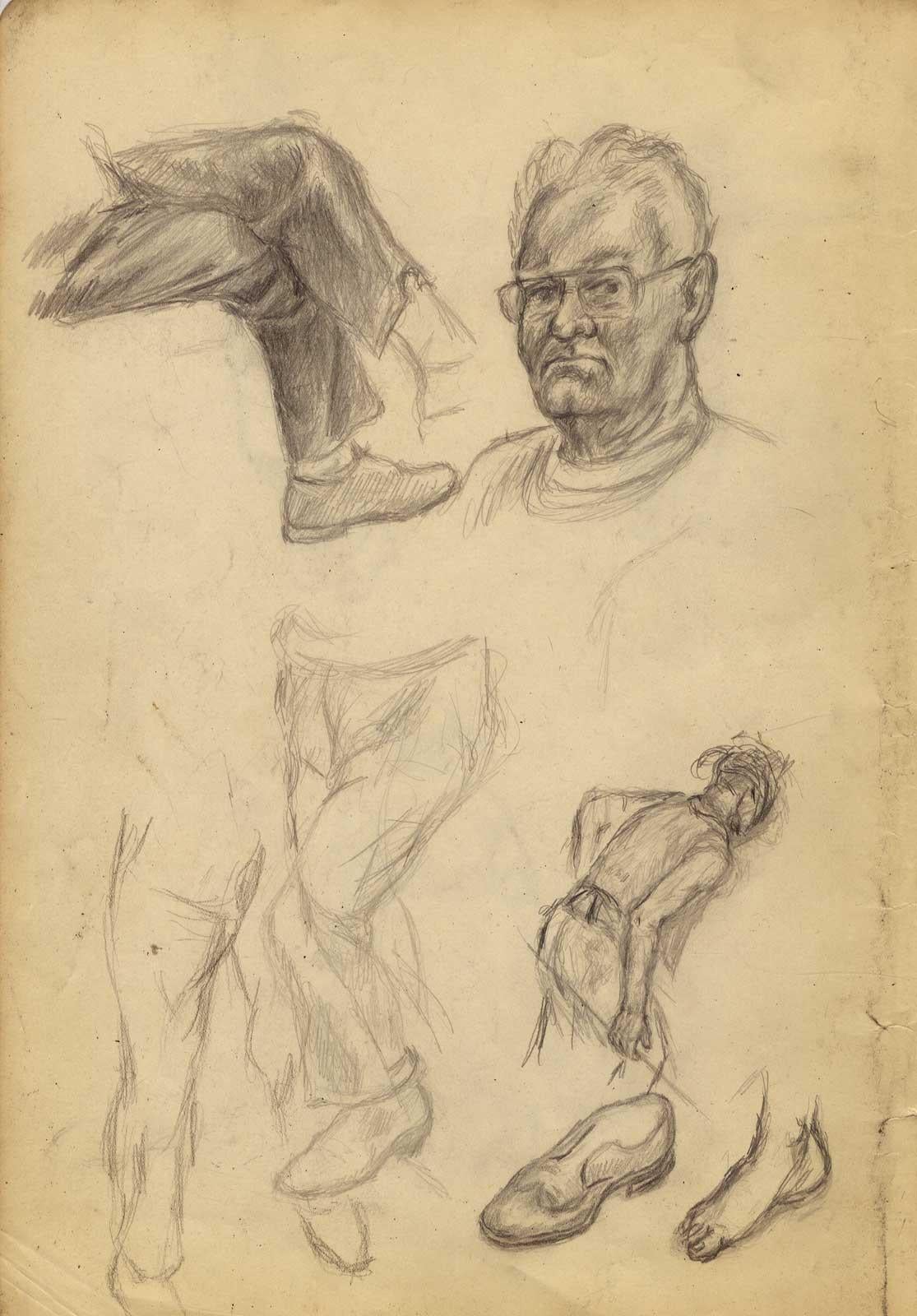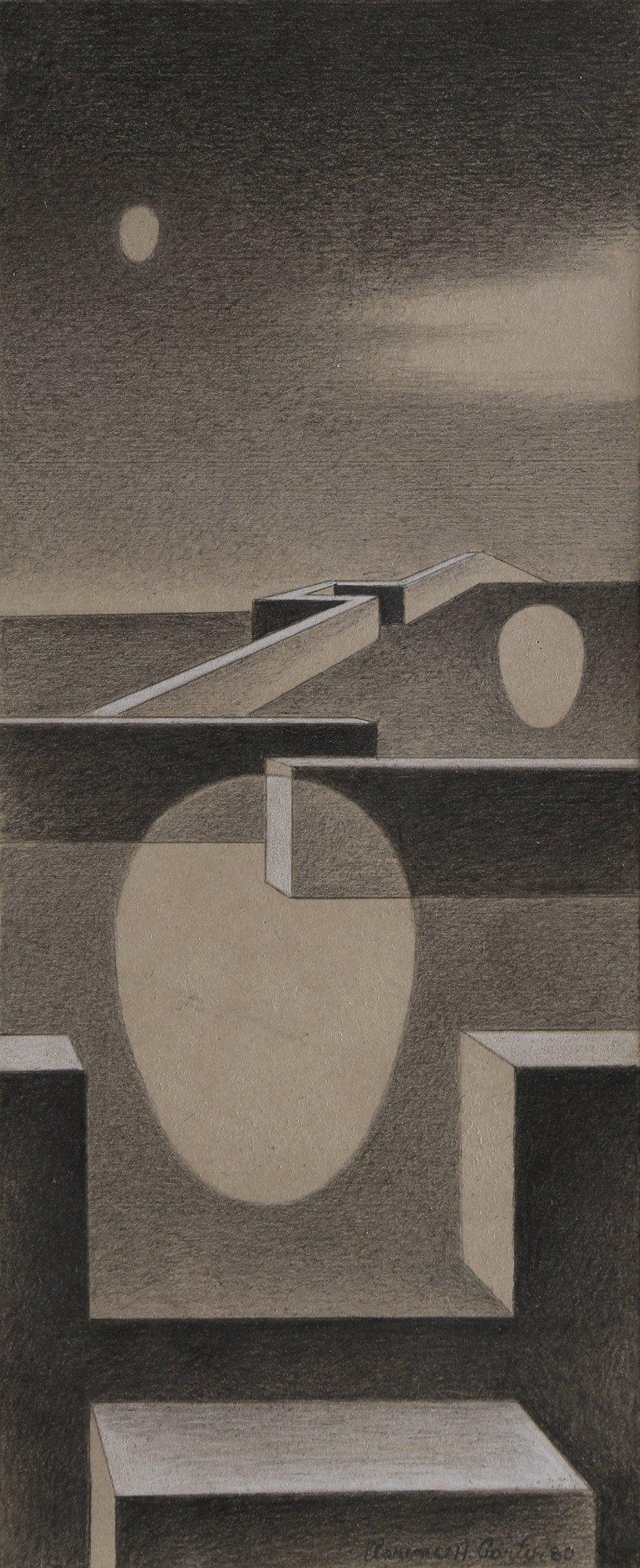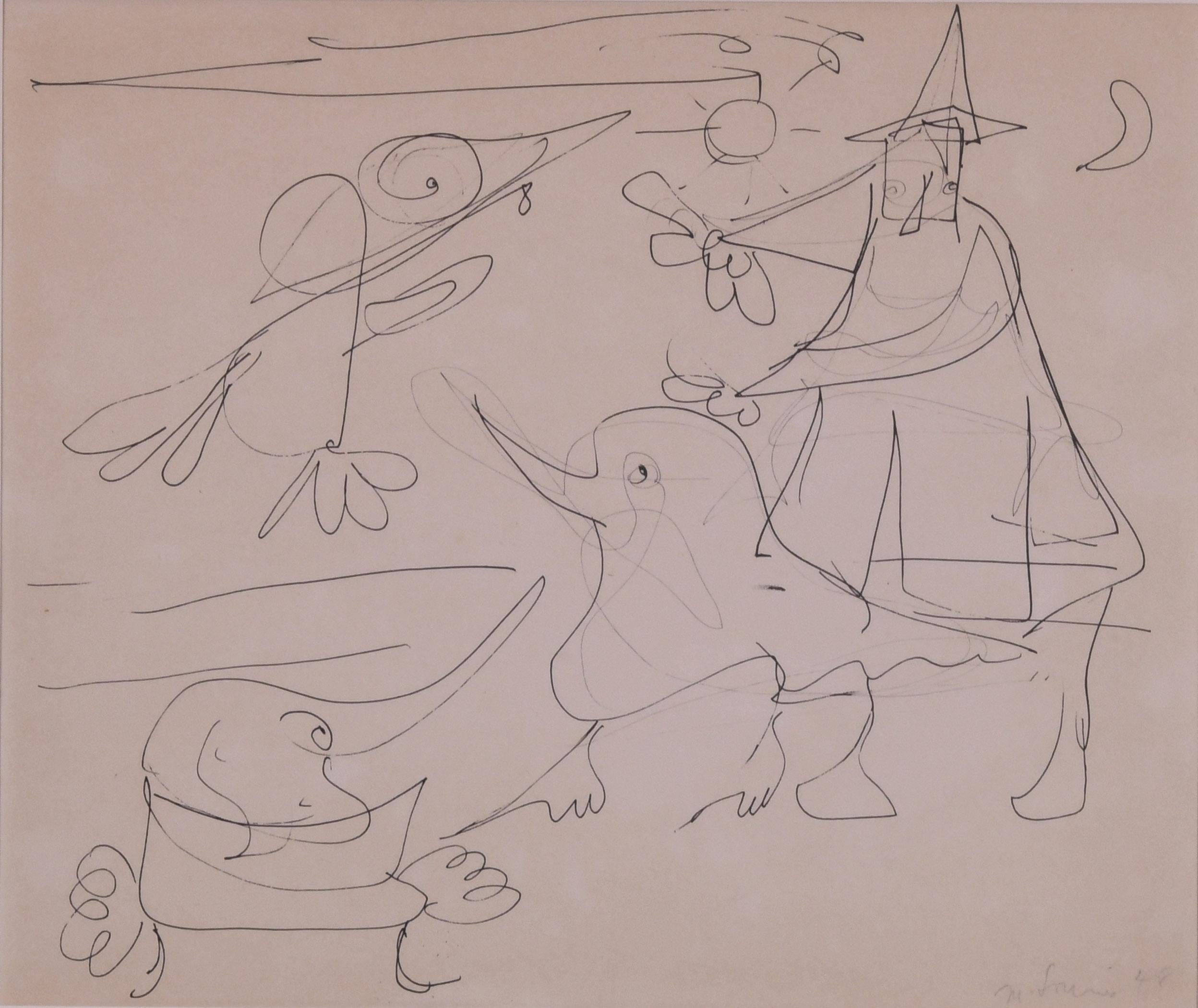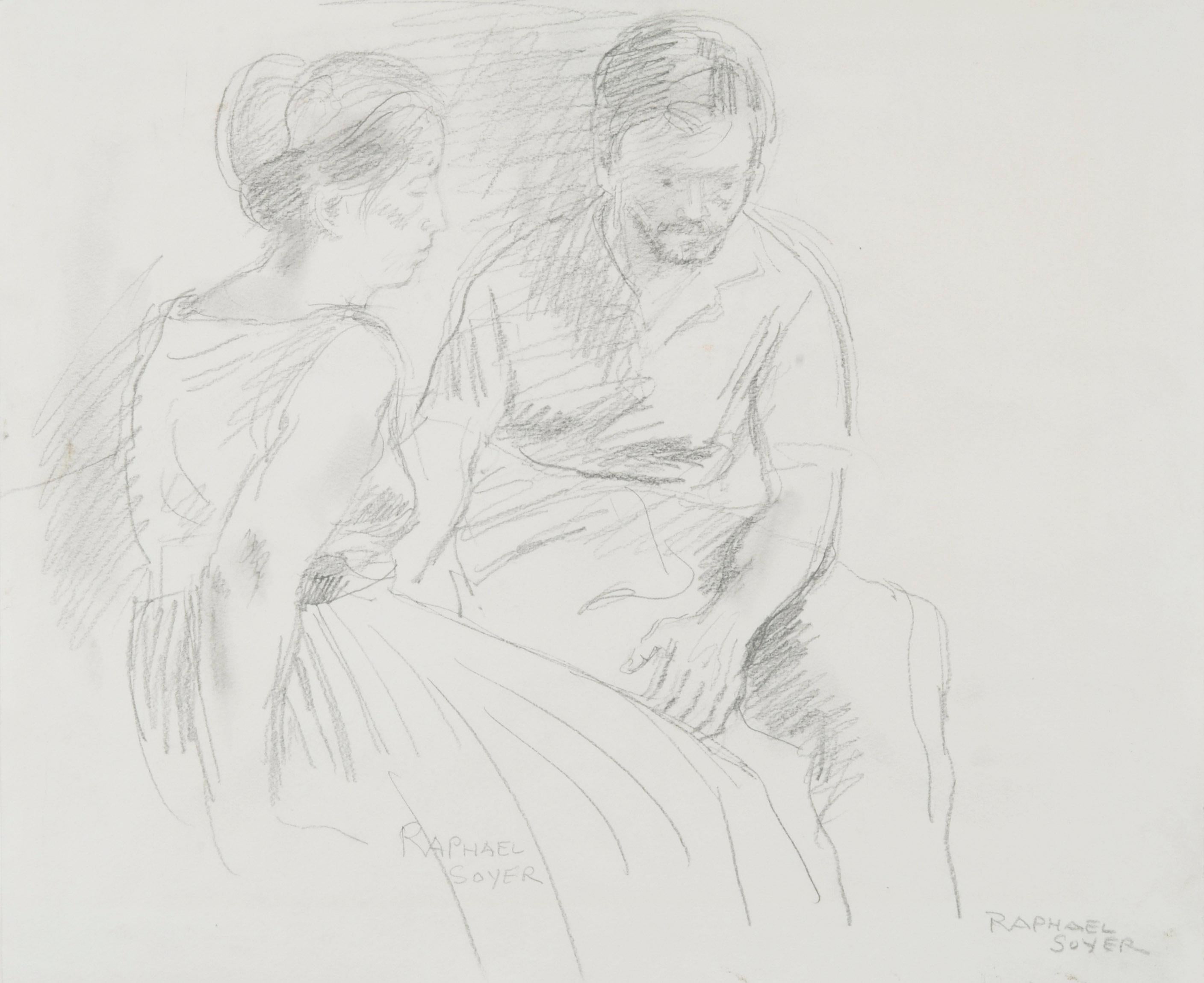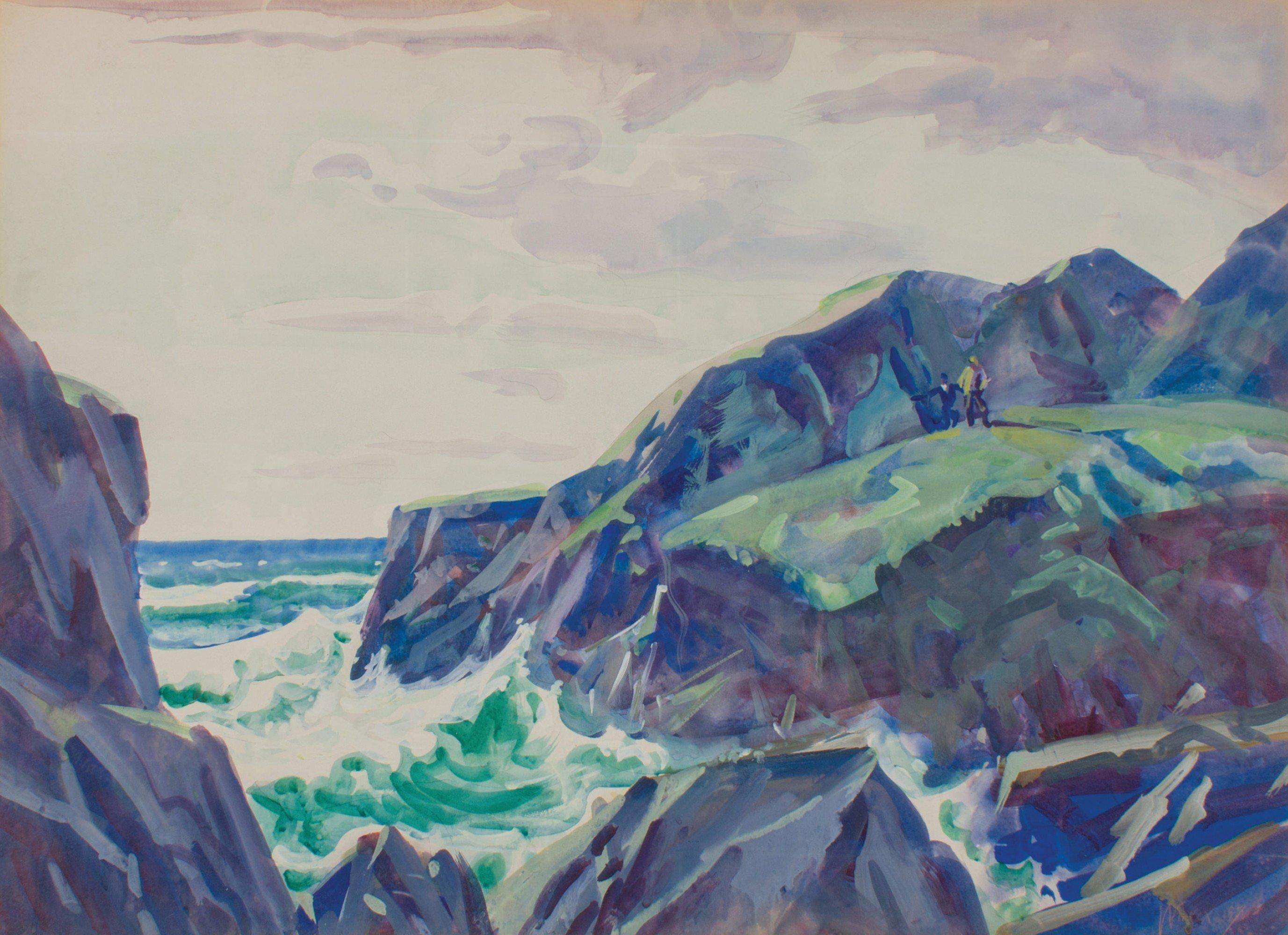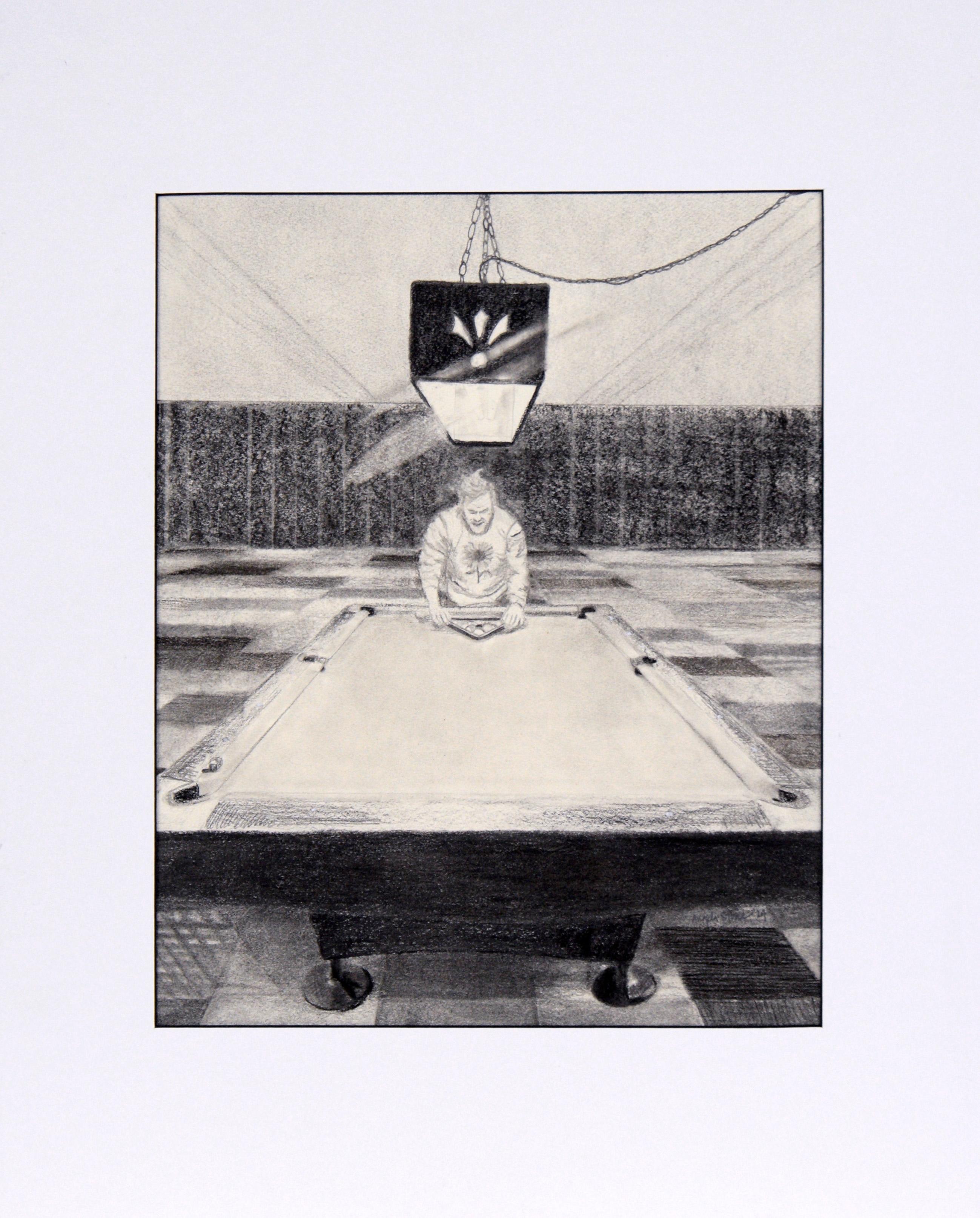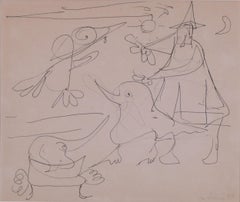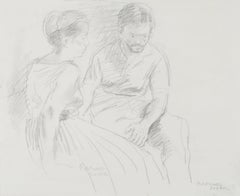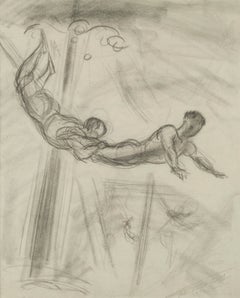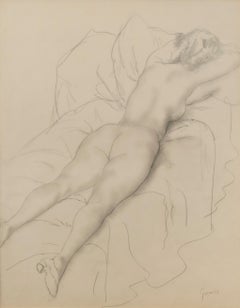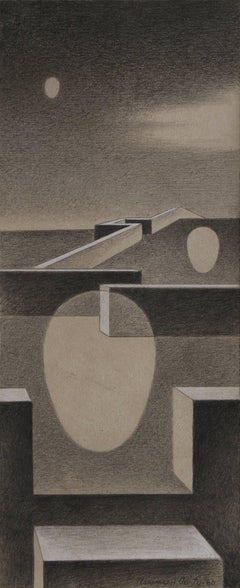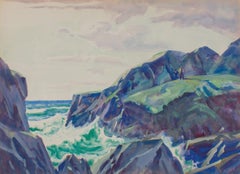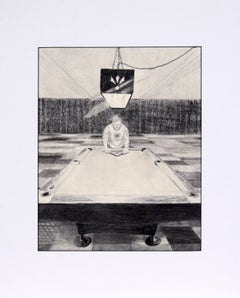Items Similar to Pablo Casals
Want more images or videos?
Request additional images or videos from the seller
1 of 7
August F. BiehlePablo Casals1963
1963
About the Item
Pablo Casals
Graphite on paper, 1963
Signed in pencil lower right (see photo)
Sheet size: 11 5/8 x 8 inches
Condition: glue residue in all four corners of the sheet
Drawn from life during an appearance at Carnegie Hall with the Cleveland Orchestra Chorus where he conducted J.S. Bach: The Passion of Our Lord According to St. Matthew (see photo of handbill)
Regarding Casals: Pau Casals i Defilló
(December 29, 1876 – October 22, 1973)
"The great Spanish cellist (and conductor), Pablo Casals (actually, Pau Carlos Salvador Defilló), legend has it, supported by Casals himself, that he was conceived when Johannes Brahms began his B-flat Major Quartet, of which Casals owned the original manuscript, and that he was born when J. Brahms completed its composition. This legend is rendered moot by the fact that the quartet in question was completed and performed before Casals was even born. But even the ascertainable facts of the life of Casals make it a glorious tale. His father, the parish organist and choirmaster in Vendrell, gave Casals instruction in piano, violin, and organ. When Casals was 11, he first heard the cello performed by a group of traveling musicians, and decided to study the instrument. In 1888 his mother took him to Barcelona, where he enrolled in the Escuela Municipal de Música. There he studied cello with José García, theory with José Rodoreda, and piano with Joaquín Malats and Francisco Costa Llobera. His progress as a cellist was nothing short of prodigious, and he was able to give a solo recital in Barcelona at the age of 14, on February 23, 1891; he graduated with honors in 1893. Albéniz, who heard him play in a cafe trio, gave Pablo Casals a 1etter of introduction to Count Morphy, the private secretary to María Cristina, the Queen Regent, in Madrid. Casals was asked to play at informal concerts in the palace, and was granted a royal stipend for composition study with Tomás Bretón. In 1893 he entered the Conservatory de Musica y Declamacion in Madrid, where he attended chamber music classes of Jesus de Monasterio. He also played in the newly organized Quartet Society there (1894-1895). In 1895 he went to Paris and, deprived of his stipend from Spain, earned a living by playing 2nd cello in the theater orchestra of the Folies Marigny. He decided to return to Spain, where he received, in 1896, an appointment to the faculty of the Escuela Municipal de Música in Barcelona; he was also principal cellist in the orchestra of the Gran Teatro del Liceo. In 1897 he appeared as soloist with the Madrid Symphony Orchestra, and was awarded the Order of Carlos III from the Queen. His career as a cello virtuoso was then assured. In 1899 Pablo Casals played at. the Crystal Palace in London, and later for Queen Victoria at her summer residence at Cowes, Isle of Wight. On November 12, 1899, he appeared as a soloist at a prestigious Lamoureux Concert in Paris, and played with Lamoureux again on December 17, 1899, obtaining exceptional success With both the public and the press. He toured Spain and Holland with the pianist Harold Bauer (1900-1901); then made his first tour of the USA (1901-1902). In 1903 he made a grand tour of South America. On January 15, 1904, he was invited to play at the White House for President Theodore Roosevelt. In 1906 he became associated with the talented young Portuguese cellist Guilhermina Suggia, who studied with him and began to appear in concerts as Mme. P. Casals-Suggia, although they were not legally married. Their liaison was dissolved in 1912; in 1914 Casals married the American socialite and singer Susan Metcalfe; they were separated in 1928, but did not divorce until 1957. Continuing his brilliant career, Pablo Casals organized, in Paris, a concert trio with the piariist Alfred Cortot and the violinist Thibaud; they played concerts together until 1937. Casals also became interested in conducting, and in 1919 he organized, in Barcelona, the Orquesta Pall Casals and led itsftrst concert on October 13, 1920. With the outbreak of the Spanish Civil War in 1936, the Orquesta Pau Casals ceased its activities. Casals was an ardent supporter of the Spanish Republican government, and after its defeat vowed never to return to Spain until democracy was restored. He settled in the French village of Prades, on the Spanish frontier; between 1939 and 1942 he made sporadic appearances as a cellist in the unoccupied zone of southern France and in Switzerland. So fierce was his opposition to the Franco regime in Spain that he declined to appear in countries that recognized the totalitarian Spanish government, making an exception when he took part ill a concert of chamber music in the White House on November 13, 1961, at the invitation of President John F. Kennedy, whom he admired. In 1950 Pablo Casals resumed his career as conductor and cellist at the Prades Festival, organized in commemoration of the bicentennial of the death of J.S. Bach; he continued leading the Prades Festivals until 1966. He made his permanent residence in 1956, when he settled in San Juan, Puerto Rico (his mother was born there when the island was still under Spanish rule). In 1957 an annual Festival Casals was inaugurated there. During all these years, he developed energetic activities as a pedagogue, leading master classes in Switzerland, Italy, Berkeley, California, and Marlboro, Vermount, some of which were televised. Pablo Casals was also a composer; perhaps his most effective work is La sardana, for an ensemble of cellos, which he composed in 1926. His oratorio El pessebre (The Manger) was performed for the first time in Acapulco, Mexico, on December 17, 1960. One of his last compositions was the Himno a las Naciones Unidas (Hymn of the United Nations); he conducted its ftrst performance in a special concert at the United Nations on October 24, 1971, 2 months before his 95th birthday. On August 3, 1957, at the age of 80, Casals married his young pupil Marta Montañez; following his death, she married the pianist Eugene Istomin, on February 15, 1975. Casals did not live to see the liberation of Spain from the Franco dictatorship, but he was posthumously honored by the Spanish government under King Juan Carlos I, which issued in 1976 a commemorative postage stamp in honor of his 100th birthday." Courtesy of Rare Classical Music
Regarding August F. Biehle
"The son of a German immigrant painter of decorative murals in Cleveland, Ohio, he achieved distinction as one of Ohio's most prolific and talented artists, especially noted for design and draftsmanship. His styles embraced Expressionism, Fauvism, Cubism, and American Scene Realism, and he worked in a variety of media including graphite, oil, gouache, pastel, tempera, and lithography.
He started drawing as a youngster and served as an apprentice to his father working on decorative commissions in Cleveland, Chicago, and surrounding areas. In 1903, when he was eighteen, he went to Munich to study at the Kunstgewerbeschule, a respected arts and crafts school. In 1908, he began working as a color consultant to Sherwin Williams Paint Company, and two years later returned to Munich where he studied at the Royal Academy and came under the influence of various modernist movements. He became an important link between these styles and Ohio painters, joining the artists' colony led by Henry Keller near Sandusky.
In the 1920s and 30s, he did numerous American Scene paintings and painted WPA murals during the Depression. From 1913 to 1952, he earned his living as a lithographer but during this time painted independently. In the 1960s, he turned to complete abstraction.
He died in 1979, having had a career of nearly seventy years. His paintings have been in numerous exhibitions including the Cleveland Museum of Art, the Butler Museum in Youngstown, the Pennsylvania Academy of Fine Arts in Philadelphia and the Whitney Museum in New York City."
Courtesy: AskArt
- Creator:August F. Biehle (1885 - 1979, American)
- Creation Year:1963
- Dimensions:Height: 11.625 in (29.53 cm)Width: 8 in (20.32 cm)
- Medium:
- Movement & Style:
- Period:
- Condition:
- Gallery Location:Fairlawn, OH
- Reference Number:Seller: FA119471stDibs: LU1407406562
About the Seller
5.0
Recognized Seller
These prestigious sellers are industry leaders and represent the highest echelon for item quality and design.
Platinum Seller
Premium sellers with a 4.7+ rating and 24-hour response times
Established in 1978
1stDibs seller since 2013
784 sales on 1stDibs
Typical response time: 1 hour
Associations
International Fine Print Dealers Association
- ShippingRetrieving quote...Shipping from: Fairlawn, OH
- Return Policy
Authenticity Guarantee
In the unlikely event there’s an issue with an item’s authenticity, contact us within 1 year for a full refund. DetailsMoney-Back Guarantee
If your item is not as described, is damaged in transit, or does not arrive, contact us within 7 days for a full refund. Details24-Hour Cancellation
You have a 24-hour grace period in which to reconsider your purchase, with no questions asked.Vetted Professional Sellers
Our world-class sellers must adhere to strict standards for service and quality, maintaining the integrity of our listings.Price-Match Guarantee
If you find that a seller listed the same item for a lower price elsewhere, we’ll match it.Trusted Global Delivery
Our best-in-class carrier network provides specialized shipping options worldwide, including custom delivery.More From This Seller
View AllUntitled (Wizard Fantasy)
By Morris Louis
Located in Fairlawn, OH
Untitled (Wizard Fantasy)
Pen and ink on paperboard, 1948
Signed and dated by the artist lower right
Extremely rare "Middle Period" drawing. One of two drawings that were given by the artist to Jeanette Kear, Chevy Chase, MD which were signed and dated by the artist. All others in the exhibition are from sketchbooks and have the estate stamp and numbering.
Exhibited at National Collection of Fine Arts, Smithsonian Institution, Dec. 6 1979-Feb. 3, 1980
and
Fogg Museum of Art, Harvard University, Feb. 22-April6, 1980
Illustrated twice in the resulting catalog, The Drawings of Morris Louis, by Diane Upright Headly, Harvard Univeristy and author of the catalog essay and entries. (See photos)
Condition: Mounted to paper board by owner, Jeanette Kear for framing
Glazed with glass
Image size: 13 7/8 x 16 5/8 inches
Frame size: 20 x 23 x 3/4 inches
Provenance: Jeanette F. Kear, Chevy Chase, MD
Illustrated: National Collection of Fine Art, 1979: "The Drawings of Morris Louis,"
Catalog No. 1, illustrated D1, reproduced p. 73
Morris Louis Bernstein (November 28, 1912 – September 7, 1962), known professionally as Morris Louis, was an American painter. During the 1950s he became one of the earliest exponents of Color Field painting. While living in Washington, D.C., Louis, along with Kenneth Noland and other Washington painters, formed an art movement that is known today as the Washington Color Schoo
Early life and education
From 1929 to 1933, he studied at the Maryland Institute of Fine and Applied Arts (now Maryland Institute College of Art) on a scholarship, but left shortly before completing the program. Louis worked at various odd jobs to support himself while painting, and in 1935 was president of the Baltimore Artists' Association. From 1936 to 1940, he lived in New York City and worked in the easel division of the Works Progress Administration Federal Art Project. During this period, he knew Arshile Gorky, David Alfaro Siqueiros, and Jack Tworkov. He also dropped his last name.
Work
Color field painting
He returned to his native Baltimore in 1940 and taught privately. In 1948, he pioneered the use of Magna paint—a newly developed oil-based acrylic paint made for him by his friends, New York paintmakers Leonard Bocour and Sam Golden. In 1952, Louis moved to Washington, D.C. Living in Washington, D.C., he was somewhat apart from the New York scene and he was working almost in isolation. During the 1950s he and a group of artists that included Kenneth Noland, Gene Davis, Thomas Downing, Howard Mehring, Anne Truitt and Hilda Thorpe...
Category
1940s American Modern Figurative Drawings and Watercolors
Materials
Graphite
Seated Couple
By Raphael Soyer
Located in Fairlawn, OH
Inspiration (Seated Couple)
Graphite on paper, c. 1967
Signed twice in pencil by the artist on recto (see photos)
Condition: Excellent
Image size: 13 x 16 inches
Note: Although not t...
Category
1960s American Modern Figurative Drawings and Watercolors
Materials
Graphite
Untitled (Study for The Aerialists)
By John Steuart Curry
Located in Fairlawn, OH
Untitled (Study for The Aerialists)
Graphite on paper, 1932
Signed lower right in pencil: "John Steuart Curry"
Dated: 1932 in pencil
Exhibited:
Schroeder Romero & Shredder, NYC (label), Master Drawings, Oct. 13, 2011-Nov. 12, 2011 (see photo of label)
Arkansas Arts Center (label), 44th Collector Show & Sale, Nov. 30-December 30, 2012, Offered at $22,000.
(see photo of label)
This drawing is closely related to a painting by Curry entitled The Aerialists, 1932, once in the Erskine Collection, Cedar Rapids, Iowa. It is part of a group of preliminary drawings and three finished paintings executed by Curry around 1932 which were based on The Flying Cadonas. The painting The Flying Cadonas is an icon of American art purchased by the Whitney Museum of Art and now on permanent exhibition.
There are other know studies for these works, nos. 199 through 222 and in John Steuart Curry: Rural America, page 32 (Mongerson Wunderlich, Chicago, 1990.
Provenance:
Mrs. Kathleen Curry (artist’s widow), included in the estate schedule of works
Treadway Toomey Auction, Oak Park, Illinois, 2009
Don Joint, New York
An important American Regionalist drawing.
Like Grant Wood and Thomas Hart Benton, John Steuart Curry was a major American scene painter of the 1930s. His subjects were taken from American history and his most famous mural, The Tragic Prelude...
Category
1930s American Modern Figurative Drawings and Watercolors
Materials
Graphite
Reclining Female Nude
By Emil Ganso
Located in Fairlawn, OH
Reclining Female Nude
Charcoal on paper, c. 1933
Signed lower right (see photo)
Provenance:
Weyhe Gallery, New York (Ganso's dealer 1925-1941)
Joseph Mark Erdelac, Cleveland, noted c...
Category
1930s American Modern Nude Drawings and Watercolors
Materials
Graphite
Isadora Duncan
By Abraham Walkowitz
Located in Fairlawn, OH
Isadora Duncan
Graphite with grey wash on paper mounted to cardstock
Signed and dated in pencil lower right (see photo)
Provenance: Charlotte Bergman, f...
Category
1910s American Modern Figurative Drawings and Watercolors
Materials
Graphite
Lonly (Lonely)
By Stephen Longstreet
Located in Fairlawn, OH
Signed lower right
Provenance:
Joseph M. Erdelac, Cleveland, OH
Possibly deaccessed from the Columbus Museum of Art
THOMAS FRENCH FINE ART, LLC
Stephen Longstreet (1907-2002)
A...
Category
20th Century American Modern Figurative Drawings and Watercolors
Materials
Watercolor
You May Also Like
Characters from the Sketchbooks (from September Storm plus Self Portrait)
By Jackson Lee Nesbitt
Located in New Orleans, LA
This is a page from the artist's sketchbooks. Six pencil drawings show figures that might have been in preparation for future lithographs, Certainly the woman with the umbrella could have been an early iteration for September Storm. There is also a self portrait of Nesbitt. Clearly the works are authentic if unsigned. Provenance: from the Nesbitt studio.
From workers wrestling with heavy machinery to a lone horseman traveling down a rut-filled country road; from the animated crowd at a livestock auction to the dignified worshippers at a serene Sunday service; Jackson Lee Nesbitt chose to represent the essence of humanity and the nobility of ordinary folk striving to get along as best they can. He studied with Thomas Hart Benton and John Demartelly...
Category
Late 20th Century American Modern Figurative Drawings and Watercolors
Materials
Graphite
Study for Worlds Beyond - Surrealist graphite drawing, Ohio artist
By Clarence Holbrook Carter
Located in Beachwood, OH
Clarence Holbrook Carter (American, 1904-2000)
Study for Worlds Beyond, 1980
Graphite, collage and white heightening on illustration board
Signed and dated lower right
10.75 x 4.5 in...
Category
1980s American Modern Figurative Drawings and Watercolors
Materials
Graphite
Crashing Waves on Atlantic Coast, Mid-century Seascape, Cleveland School Artist
By Frank Wilcox
Located in Beachwood, OH
Frank Nelson Wilcox (American, 1887-1964)
Crashing Waves on the Atlantic Coast, 1957
Watercolor and graphite on paper
Signed and dated lower right
22 x 29 inches
Frank Nelson Wilcox (October 3, 1887 – April 17, 1964) was a modernist American artist and a master of watercolor. Wilcox is described as the "Dean of Cleveland School painters," though some sources give this appellation to Henry Keller or Frederick Gottwald. Wilcox was born on October 3, 1887 to Frank Nelson Wilcox, Sr. and Jessie Fremont Snow Wilcox at 61 Linwood Street in Cleveland, Ohio. His father, a prominent lawyer, died at home in 1904 shortly before Wilcox' 17th birthday. His brother, lawyer and publisher Owen N. Wilcox, was president of the Gates Legal Publishing Company or The Gates Press. His sister Ruth Wilcox was a respected librarian.
In 1906 Wilcox enrolled from the Cleveland School of Art under the tutelage of Henry Keller, Louis Rorimer, and Frederick Gottwald. He also attended Keller's Berlin Heights summer school from 1909. After graduating in 1910, Wilcox traveled and studied in Europe, sometimes dropping by Académie Colarossi in the evening to sketch the model or the other students at their easels, where he was influenced by French impressionism. Wilcox was influenced by Keller's innovative watercolor techniques, and from 1910 to 1916 they experimented together with impressionism and post-impressionism. Wilcox soon developed his own signature style in the American Scene or Regionalist tradition of the early 20th century. He joined the Cleveland School of Art faculty in 1913. Among his students were Lawrence Edwin Blazey, Carl Gaertner, Paul Travis, and Charles E. Burchfield. Around this time Wilcox became associated with Cowan Pottery.
In 1916 Wilcox married fellow artist Florence Bard, and they spent most of their honeymoon painting in Berlin Heights with Keller. They had one daughter, Mary. In 1918 he joined the Cleveland Society of Artists, a conservative counter to the Bohemian Kokoon Arts Club, and would later serve as its president. He also began teaching night school at the John Huntington Polytechnic Institute at this time, and taught briefly at Baldwin-Wallace College.
Wilcox wrote and illustrated Ohio Indian Trails in 1933, which was favorably reviewed by the New York Times in 1934. This book was edited and reprinted in 1970 by William A. McGill. McGill also edited and reprinted Wilcox' Canals of the Old Northwest in 1969. Wilcox also wrote, illustrated, and published Weather Wisdom in 1949, a limited edition (50 copies) of twenty-four serigraphs (silk screen prints) accompanied by commentary "based upon familiar weather observations commonly made by people living in the country."
Wilcox displayed over 250 works at Cleveland's annual May Show. He received numerous awards, including the Penton Medal for as The Omnibus, Paris (1920), Fish Tug on Lake Erie (1921), Blacksmith Shop (1922), and The Gravel Pit (1922). Other paintings include The Trailing Fog (1929), Under the Big Top (1930), and Ohio Landscape...
Category
1950s American Modern Figurative Drawings and Watercolors
Materials
Watercolor, Graphite
"Loser's Rack" - Original Charcoal and Graphite Drawing on Paper
Located in Soquel, CA
"Loser's Rack" - Original Charcoal and Graphite Drawing on Paper
This drawing by California artist, Angela Stone (American, b. 1983), provides brilliant 1-point perspective in a val...
Category
21st Century and Contemporary American Modern Interior Drawings and Wate...
Materials
Paper, Charcoal, Graphite
$280 Sale Price
20% Off
Original Black and White Graphite Sketch for Mural: Figure on Horseback Drawing
Located in Denver, CO
This untitled graphite drawing on paper by Verona Burkhard (1910-2004) features a dynamic figure on horseback, serving as a preliminary sketch for a larger mural. The work highlights Burkhard’s skillful use of graphite to capture movement and form. Presented in a custom frame with all archival materials, the framed dimensions measure 29 ¾ x 22 ¾ inches, with the image size at 23 ½ x 16 ¼ inches.
In very good vintage condition, this drawing represents Burkhard's early artistic process for her mural work. Expedited and international shipping options are available; please contact us for a personalized quote.
About the Artist: Verona Lorriane Burkhard, born on June 8, 1910, was an accomplished American artist known for her murals, paintings, and contributions to the art community. Raised in New Jersey and New York, Burkhard studied at the Art Students League under Boardman Robinson and at Columbia University with Frank Mechau...
Category
20th Century American Modern Animal Drawings and Watercolors
Materials
Graphite
Surprised Woman with Cactus 1920s Female Illustrator
By Susan Flint
Located in Miami, FL
The postman's delivery of a limp cactus creates a big emotional response the female recipient. Most likely an interior illustration for a newsstand magazine. Signed lower right Sus...
Category
1930s American Modern Figurative Drawings and Watercolors
Materials
Paper, Graphite
